air condition TOYOTA IQ 2012 Owners Manual
[x] Cancel search | Manufacturer: TOYOTA, Model Year: 2012, Model line: IQ, Model: TOYOTA IQ 2012Pages: 476, PDF Size: 23.52 MB
Page 1 of 476

TABLE OF CONTENTS
1
iQ_WE_74014E
1Before drivingAdjusting and operating features such as door locks,
mirrors, and steering column.
2When drivingDriving, stopping and safe-driving information.
3Interior featuresAir conditioning and audio systems, as well as other
interior features for a comfortable driving experience.
4Maintenance and
careCleaning and protecting your vehicle, performing do-it-
yourself maintenance, and maintenance information.
5When trouble
arisesWhat to do if the vehicle needs to be towed, gets a flat
tire, or is involved in an accident.
6Vehicle specifi-
cationsDetailed vehicle information.
IndexAlphabetical listing of information contained in this
manual.
Page 3 of 476

1
2
3
4
5
6
3
iQ_WE_74014E
2-3. Operating the lights and
wipers
Headlight switch.................. 211
Fog light switch ................... 216
Windshield wipers and
washer .............................. 218
Rear window wiper and
washer .............................. 222
2-4. Using other driving systems
Driving assist systems ........ 224
2-5. Driving information
Cargo and luggage ............. 229
Winter driving tips ............... 231
Trailer towing ...................... 235
.
3-1. Using the air conditioning
system and defogger
Manual air conditioning
system .............................. 238
Automatic air conditioning
system .............................. 244
Rear window defogger ........ 252
Rear window and outside
rear view mirror
defoggers.......................... 2543-2. Using the audio system
Audio system type .............. 257
Using the radio ................... 260
Using the CD player ........... 265
Playing back MP3 and
WMA discs ....................... 272
Optimal use of the audio
system.............................. 280
Using the AUX port ............ 282
Using the steering wheel
audio switches ................. 284
3-3. Using the interior lights
Interior lights list ................. 286
• Interior light ...................... 287
3-4. Using the storage features
List of storage features....... 288
• Cup holder ....................... 289
• Bottle holders ................... 289
• Auxiliary box..................... 290
3-5. Other interior features
Sun visors .......................... 293
Vanity mirrors ..................... 294
Power outlet ....................... 295
Seat heaters ....................... 296
Assist grips ......................... 298
Floor mat ............................ 299
Luggage compartment
features ............................ 301
3Interior features
Page 4 of 476

TABLE OF CONTENTSIndex
4
iQ_WE_74014E
4-1. Maintenance and care
Cleaning and protecting
the vehicle exterior ........... 306
Cleaning and protecting
the vehicle interior ............ 310
4-2. Maintenance
Maintenance
requirements..................... 313
4-3. Do-it-yourself maintenance
Do-it-yourself service
precautions ....................... 316
Hood ................................... 319
Positioning a floor jack ........ 321
Replacing the tire ................ 324
Engine compartment........... 334
Tires .................................... 347
Tire inflation pressure ......... 350
Wheels ................................ 352
Air conditioning filter ........... 354
Key battery.......................... 357
Checking and replacing
fuses ................................. 361
Light bulbs .......................... 3735-1. Essential information
Emergency flashers ........... 386
If your vehicle needs to
be towed .......................... 388
If you think something is
wrong ............................... 395
Fuel pump shut off
system.............................. 396
5-2. Steps to take in an emergency
If a warning light turns
on or a warning buzzer
sounds... .......................... 397
If you have a flat tire ........... 405
If the engine will not start ... 423
If the shift lever cannot be
shifted from P (vehicles
with a Multidrive) .............. 425
If you lose your keys .......... 426
If the electronic key does
not operate properly
(vehicles with smart
entry & start system) ........ 427
If the vehicle battery is
discharged ....................... 430
If your vehicle overheats .... 435
If the vehicle becomes
stuck................................. 438
If your vehicle has
to be stopped
in an emergency .............. 440
4Maintenance and care5When trouble arises
Page 14 of 476

14
iQ_WE_74014E
Pictorial indexInstrument panel
(Left-hand drive vehicles)
Power outlet P. 295
Emergency flashers switch P. 386
Air conditioning system P. 238
Rear window defogger switch/
rear window defogger and outside rear view
mirror defoggers switch
P. 252, 254
Vehicles with a manual air conditioning system
Page 15 of 476

15
iQ_WE_74014E
Vehicles with an automatic air conditioning system
: If equipped
Air conditioning system P. 244
Emergency flashers switch P. 386
Power outlet P. 295
Rear window defogger switch/
rear window defogger and outside rear view
mirror defoggers switch
P. 252, 254
Page 25 of 476
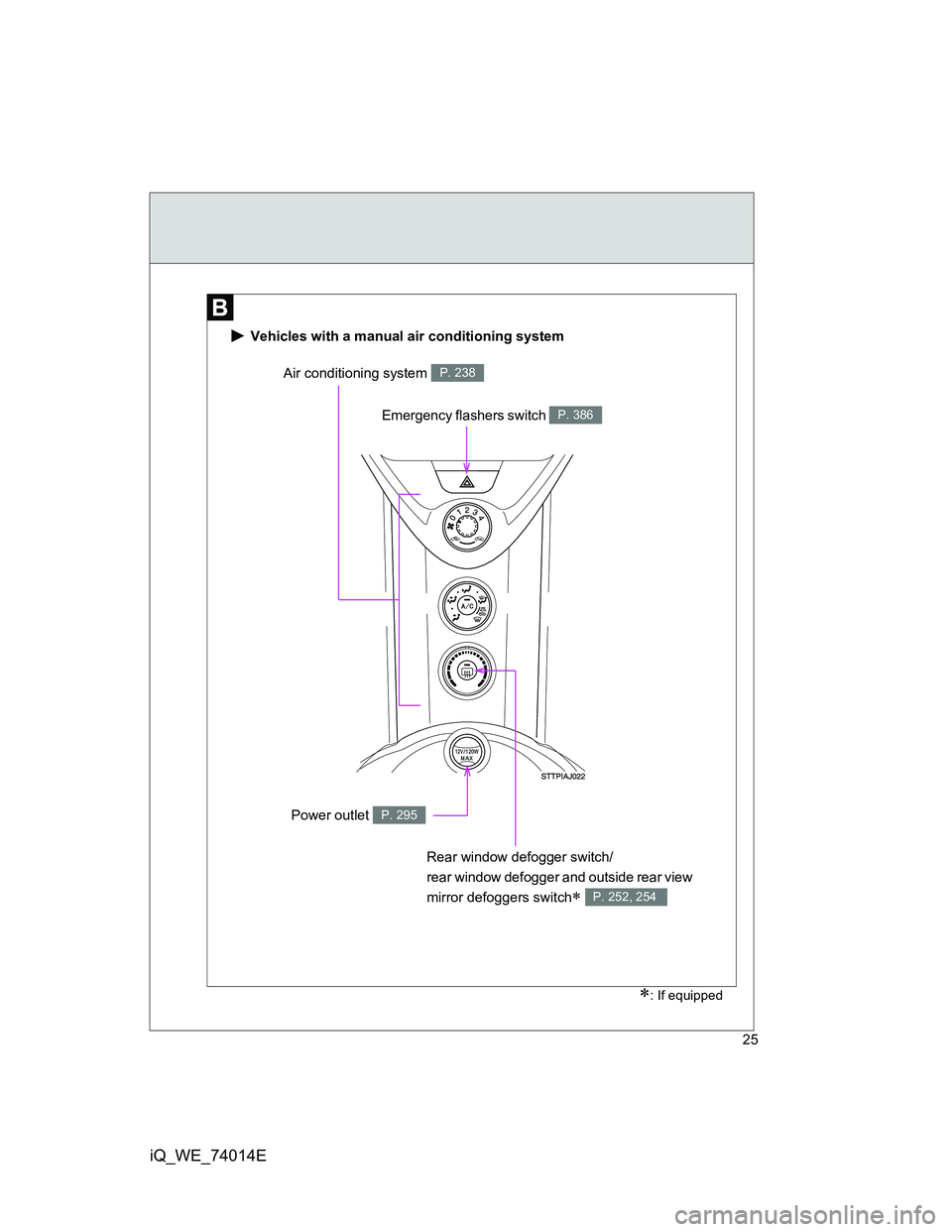
25
iQ_WE_74014E
Power outlet P. 295
Emergency flashers switch P. 386
Air conditioning system P. 238
Rear window defogger switch/
rear window defogger and outside rear view
mirror defoggers switch
P. 252, 254
Vehicles with a manual air conditioning system
: If equipped
Page 26 of 476
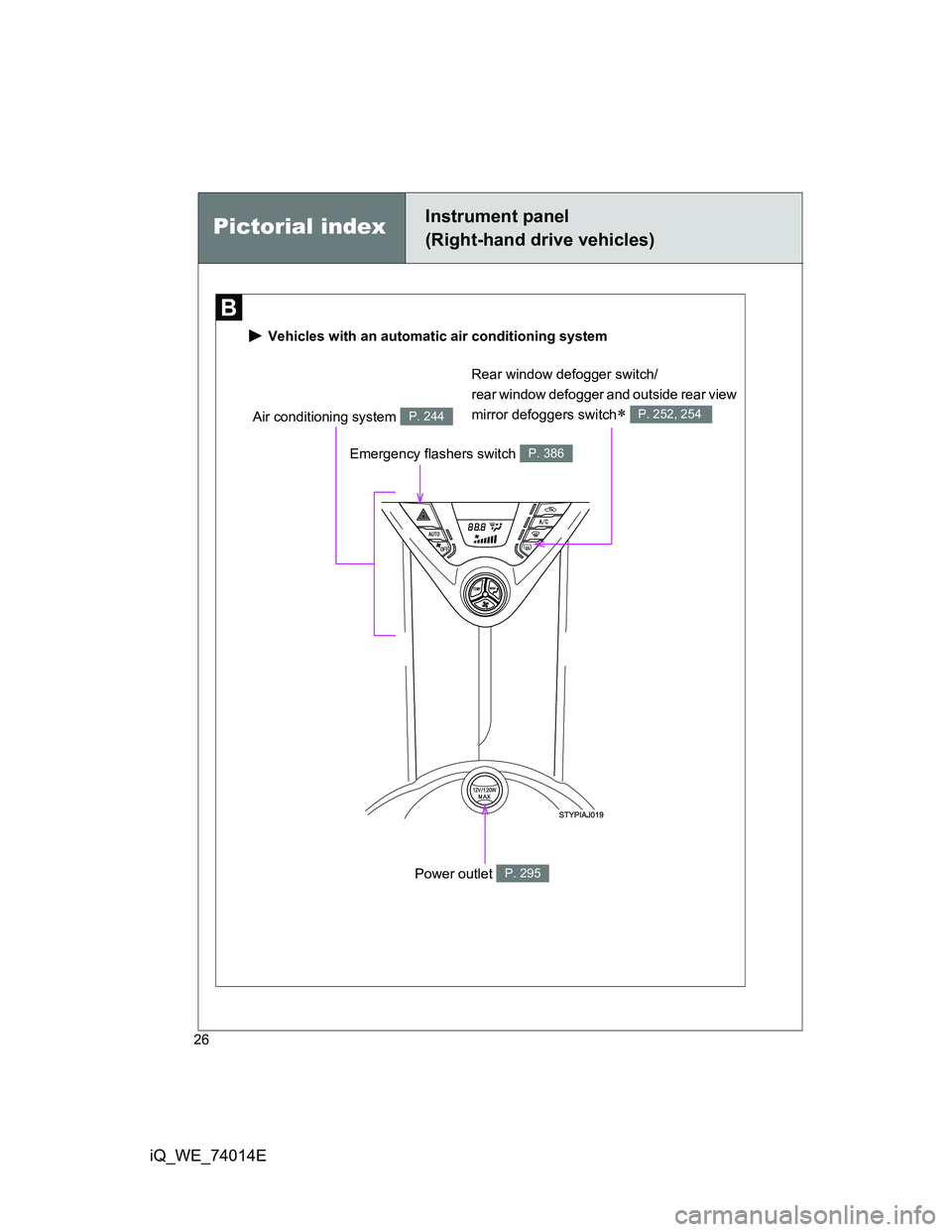
26
iQ_WE_74014E
Pictorial indexInstrument panel
(Right-hand drive vehicles)
Vehicles with an automatic air conditioning system
Air conditioning system P. 244
Emergency flashers switch P. 386
Power outlet P. 295
Rear window defogger switch/
rear window defogger and outside rear view
mirror defoggers switch
P. 252, 254
Page 61 of 476
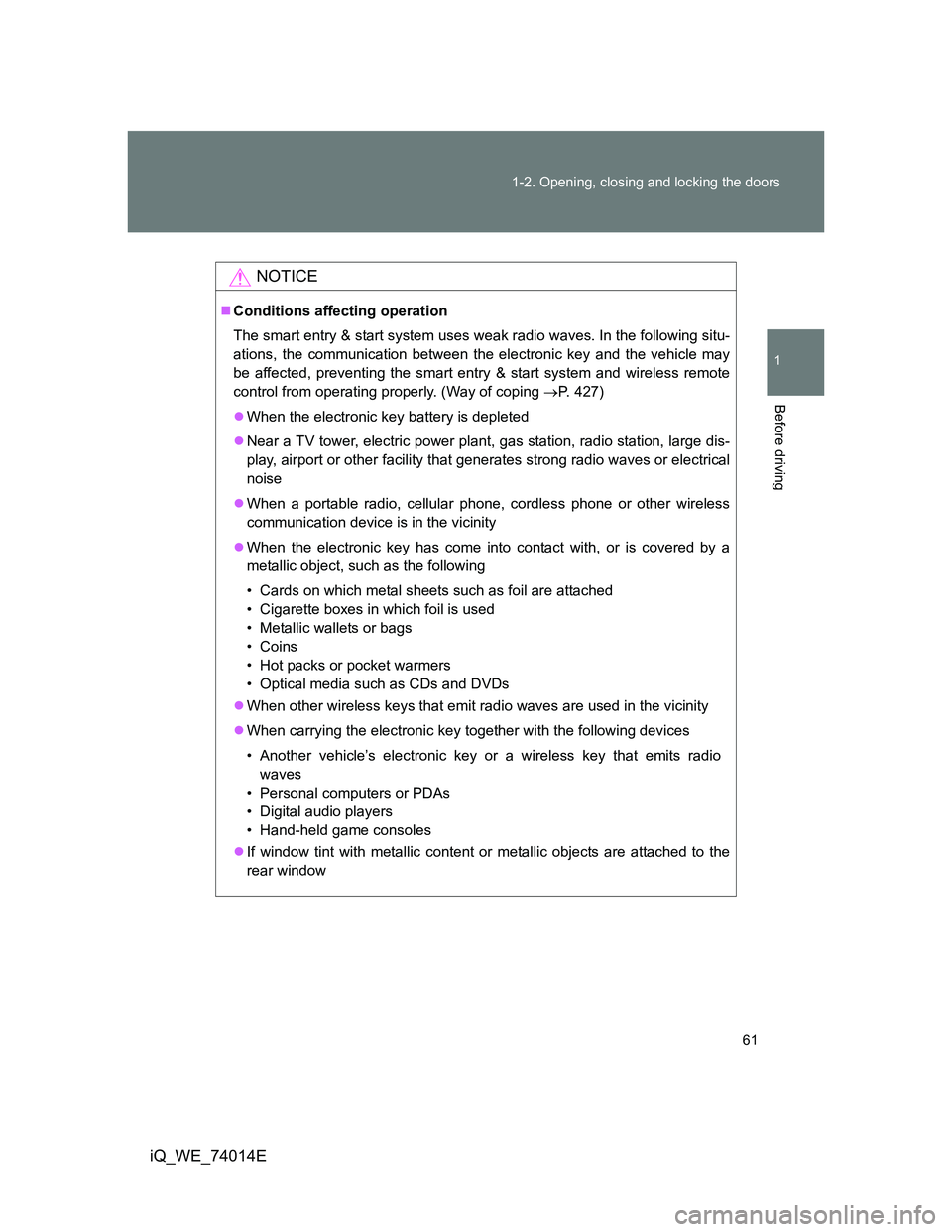
61 1-2. Opening, closing and locking the doors
1
Before driving
iQ_WE_74014E
NOTICE
Conditions affecting operation
The smart entry & start system uses weak radio waves. In the following situ-
ations, the communication between the electronic key and the vehicle may
be affected, preventing the smart entry & start system and wireless remote
control from operating properly. (Way of coping P. 427)
When the electronic key battery is depleted
Near a TV tower, electric power plant, gas station, radio station, large dis-
play, airport or other facility that generates strong radio waves or electrical
noise
When a portable radio, cellular phone, cordless phone or other wireless
communication device is in the vicinity
When the electronic key has come into contact with, or is covered by a
metallic object, such as the following
• Cards on which metal sheets such as foil are attached
• Cigarette boxes in which foil is used
• Metallic wallets or bags
• Coins
• Hot packs or pocket warmers
• Optical media such as CDs and DVDs
When other wireless keys that emit radio waves are used in the vicinity
When carrying the electronic key together with the following devices
• Another vehicle’s electronic key or a wireless key that emits radio
waves
• Personal computers or PDAs
• Digital audio players
• Hand-held game consoles
If window tint with metallic content or metallic objects are attached to the
rear window
Page 64 of 476
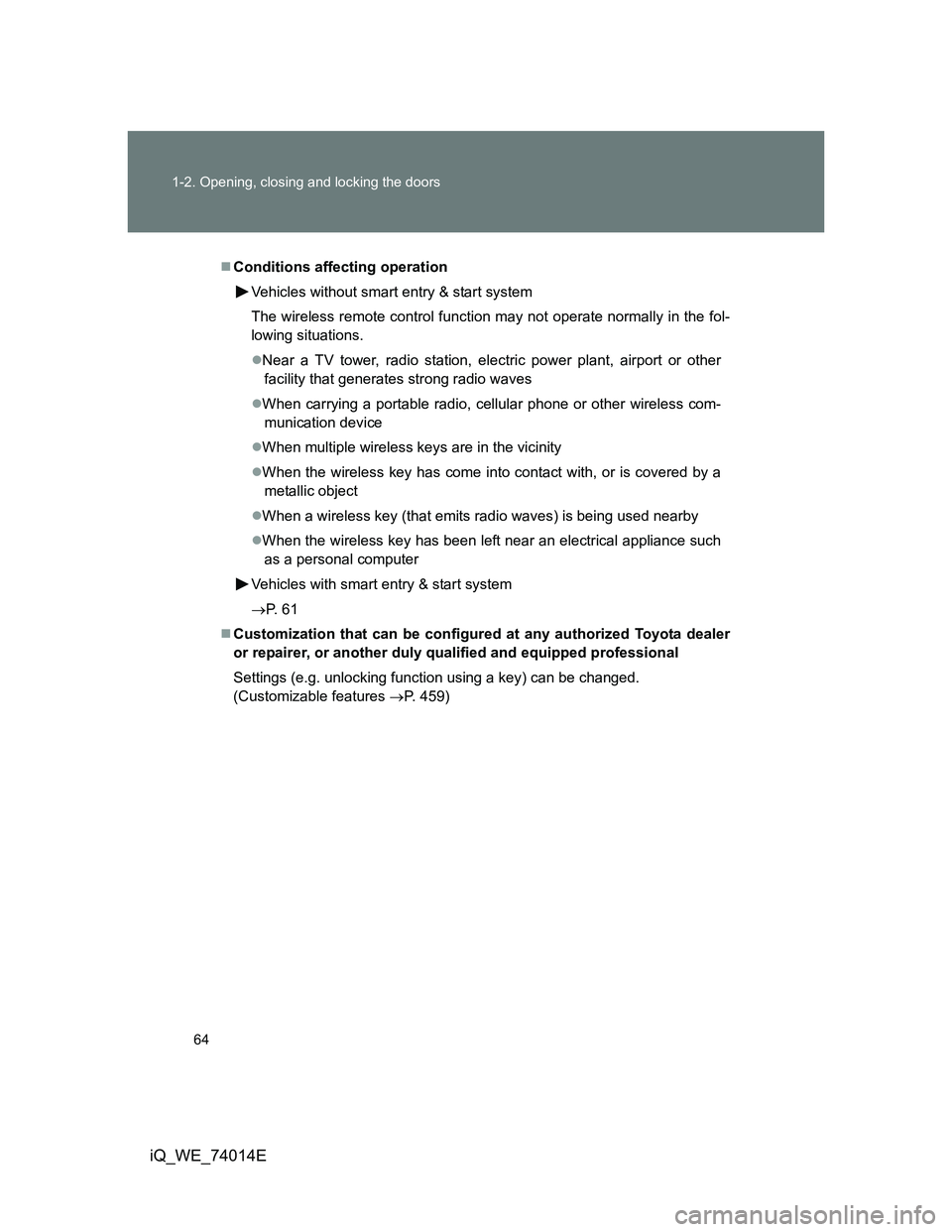
64 1-2. Opening, closing and locking the doors
iQ_WE_74014E
Conditions affecting operation
Vehicles without smart entry & start system
The wireless remote control function may not operate normally in the fol-
lowing situations.
Near a TV tower, radio station, electric power plant, airport or other
facility that generates strong radio waves
When carrying a portable radio, cellular phone or other wireless com-
munication device
When multiple wireless keys are in the vicinity
When the wireless key has come into contact with, or is covered by a
metallic object
When a wireless key (that emits radio waves) is being used nearby
When the wireless key has been left near an electrical appliance such
as a personal computer
Vehicles with smart entry & start system
P. 6 1
Customization that can be configured at any authorized Toyota dealer
or repairer, or another duly qualified and equipped professional
Settings (e.g. unlocking function using a key) can be changed.
(Customizable features P. 459)
Page 127 of 476
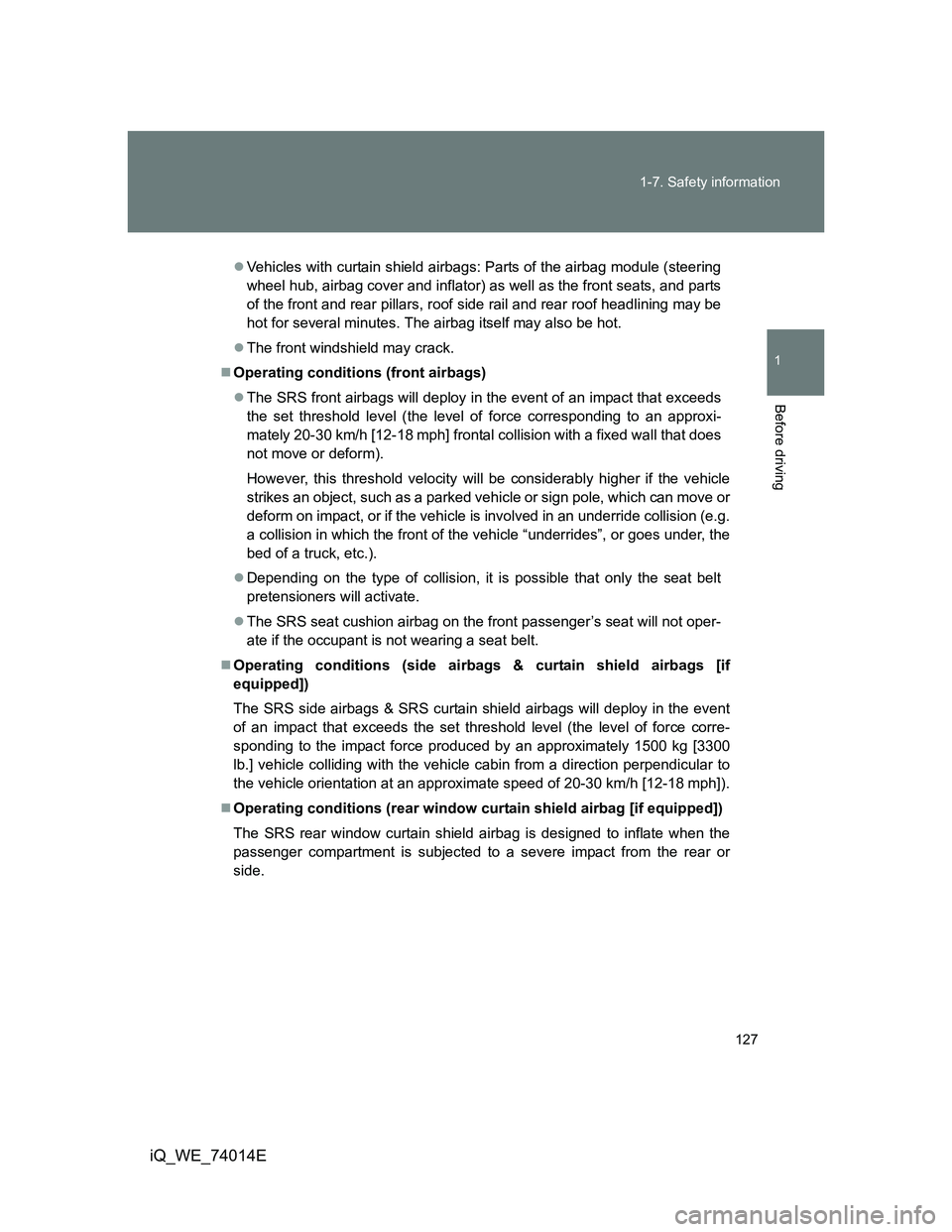
127 1-7. Safety information
1
Before driving
iQ_WE_74014E
Vehicles with curtain shield airbags: Parts of the airbag module (steering
wheel hub, airbag cover and inflator) as well as the front seats, and parts
of the front and rear pillars, roof side rail and rear roof headlining may be
hot for several minutes. The airbag itself may also be hot.
The front windshield may crack.
Operating conditions (front airbags)
The SRS front airbags will deploy in the event of an impact that exceeds
the set threshold level (the level of force corresponding to an approxi-
mately 20-30 km/h [12-18 mph] frontal collision with a fixed wall that does
not move or deform).
However, this threshold velocity will be considerably higher if the vehicle
strikes an object, such as a parked vehicle or sign pole, which can move or
deform on impact, or if the vehicle is involved in an underride collision (e.g.
a collision in which the front of the vehicle “underrides”, or goes under, the
bed of a truck, etc.).
Depending on the type of collision, it is possible that only the seat belt
pretensioners will activate.
The SRS seat cushion airbag on the front passenger’s seat will not oper-
ate if the occupant is not wearing a seat belt.
Operating conditions (side airbags & curtain shield airbags [if
equipped])
The SRS side airbags & SRS curtain shield airbags will deploy in the event
of an impact that exceeds the set threshold level (the level of force corre-
sponding to the impact force produced by an approximately 1500 kg [3300
lb.] vehicle colliding with the vehicle cabin from a direction perpendicular to
the vehicle orientation at an approximate speed of 20-30 km/h [12-18 mph]).
Operating conditions (rear window curtain shield airbag [if equipped])
The SRS rear window curtain shield airbag is designed to inflate when the
passenger compartment is subjected to a severe impact from the rear or
side.